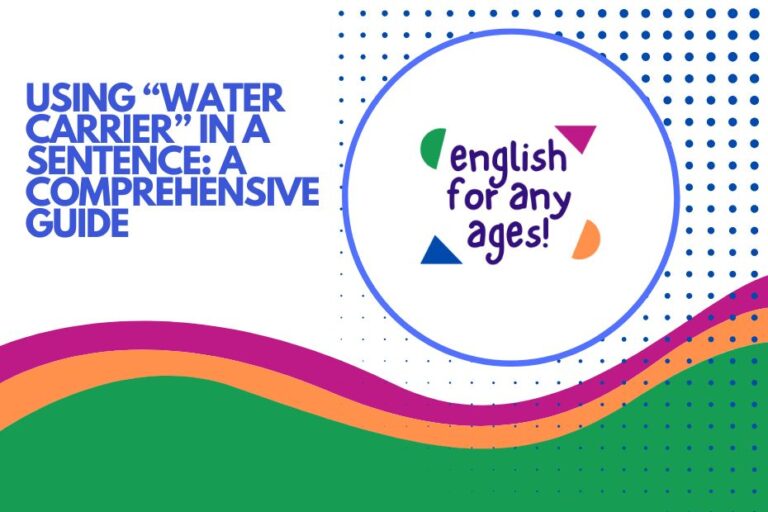Mastering “Ridge”: A Comprehensive Guide to Usage in Sentences
The word “ridge” appears in various contexts, from geographical descriptions to metaphorical expressions. Understanding how to use “ridge” correctly can significantly enhance your writing and speaking skills.
This article provides a comprehensive guide to the usage of “ridge” in sentences, covering its definitions, structural patterns, types, common mistakes, and advanced applications.
Whether you are a beginner or an advanced learner, this guide will equip you with the knowledge and practice necessary to master the use of “ridge” effectively.
Table of Contents
- Introduction
- Definition of “Ridge”
- Structural Breakdown
- Types and Categories of Ridges
- Examples of “Ridge” in Sentences
- Usage Rules for “Ridge”
- Common Mistakes with “Ridge”
- Practice Exercises
- Advanced Topics
- Frequently Asked Questions (FAQ)
- Conclusion
Introduction
The word “ridge” might initially conjure images of mountains and landscapes, but its usage extends far beyond geographical contexts. From describing anatomical features to metaphorical representations of boundaries or high points, “ridge” is a versatile term in the English language.
This article is designed to provide a complete understanding of the word “ridge,” ensuring that you can use it confidently and accurately in both written and spoken English. By exploring its various definitions, structural patterns, and contextual applications, you will gain a deep appreciation for its nuanced meanings.
This comprehensive guide caters to English learners of all levels, from beginners seeking a foundational understanding to advanced speakers aiming to refine their vocabulary and grammar. Through detailed explanations, numerous examples, and practical exercises, you will develop a solid grasp of how to incorporate “ridge” into your everyday communication.
Whether you’re writing an essay, giving a presentation, or simply engaging in a conversation, mastering the use of “ridge” will undoubtedly elevate your language proficiency.
Definition of “Ridge”
“Ridge” is a multifaceted word with several related meanings. Understanding these different definitions is crucial for using the word correctly in various contexts.
Here’s a breakdown of its primary definitions:
1. Geographical Ridge: This is the most common understanding of “ridge.” It refers to a long, narrow elevated crest of land, typically forming part of a mountain range or hill system. It’s characterized by having steep sides and a defined summit or crest. This is the literal and most frequently encountered definition.
2. Anatomical Ridge: In anatomy, a ridge can refer to a raised or projecting part on a bone or other structure. For instance, one might describe a ridge on a bone in the skull. This definition extends the concept of a linear elevation to the human body.
3. Metaphorical Ridge: Beyond its literal meanings, “ridge” can be used metaphorically to represent a high point, a boundary, or a dividing line. It can symbolize the peak of an experience or the edge of a critical situation. This usage adds depth and nuance to writing.
4. Technical/Industrial Ridge: In technical contexts, a ridge may refer to a raised strip or rib on a surface, often designed for reinforcement or grip. Examples can be found in construction and manufacturing.
Classification: “Ridge” can function as both a noun and, less commonly, a verb. As a noun, it names a specific feature (e.g., “the mountain ridge”). As a verb, it means to form into ridges or to mark with ridges (e.g., “the plowed field was ridged”).
Function: The function of “ridge” depends on its context. Geographically, it describes a landform. Anatomically, it identifies a structural feature. Metaphorically, it conveys an abstract concept of a high point or boundary.
Structural Breakdown
Understanding the structural patterns in which “ridge” appears is key to using it effectively. Here’s a breakdown of common sentence structures involving “ridge”:
1. “The [adjective] ridge [verb]…” This pattern is common when describing geographical features. The adjective modifies the ridge, and the verb describes its action or state. For example:
- The snowy ridge dominated the skyline.
- The jagged ridge presented a challenge to climbers.
2. “[Subject] climbed/walked/ascended the [adjective] ridge.” This structure focuses on an action related to a ridge. The adjective provides additional detail about the ridge. For example:
- The hikers climbed the steep ridge.
- We walked along the windy ridge.
3. “Ridge of [noun].” This pattern is often used to describe the composition or location of the ridge. The noun specifies what the ridge is made of or where it is located. For example:
- Ridge of mountains
- Ridge of sand
4. “[Adjective] ridge.” This simple structure is used when the context makes it clear what kind of ridge is being discussed. For example:
- The highest ridge.
- A rocky ridge.
5. “Ridge” as part of a compound noun: Ridge can combine with other words to form compound nouns, such as “ridgepole” (the beam running along the ridge of a roof) or “backbone ridge” (describing some animals).
Types and Categories of Ridges
Ridges can be categorized based on their formation, composition, and context. Here’s a breakdown of different types of ridges:
1. Geographical Ridges:
- Mountain Ridges: Formed by tectonic activity and erosion. These are typically the most prominent and extensive ridges.
- Hill Ridges: Smaller and less steep than mountain ridges, often formed by similar geological processes.
- Coastal Ridges: Formed by wave action and sediment deposition along coastlines.
- Glacial Ridges (Moraines): Formed by the deposition of debris carried by glaciers.
2. Anatomical Ridges:
- Bone Ridges: Raised areas on bones that serve as attachment points for muscles or ligaments.
- Skin Ridges: The raised lines on the skin of fingers and toes, forming fingerprints and footprints.
3. Technical/Industrial Ridges:
- Roof Ridges: The highest point of a roof, often reinforced with a ridgepole.
- Tire Ridges: Grooves on tires that provide traction.
- Corrugated Ridges: Found on materials like cardboard or metal for added strength.
4. Metaphorical Ridges:
- Ridge of Success: Representing the peak of achievement.
- Ridge of Tension: Signifying a high point of stress or anxiety.
Examples of “Ridge” in Sentences
Below are several tables with examples of “ridge” used in sentences, categorized for clarity.
Geographical Ridges
The following table provides examples of “ridge” used in the context of geographical features. These examples demonstrate how “ridge” is used to describe various landforms and their characteristics.
| Sentence | Explanation |
|---|---|
| The hikers struggled to reach the top of the mountain ridge. | Describes the destination of a hike. |
| A thick fog enveloped the forested ridge, making visibility poor. | Describes a ridge covered in trees and obscured by fog. |
| From the rocky ridge, we could see the entire valley below. | Describes a ridge made of rocks and offering a panoramic view. |
| The snow-covered ridge glistened in the morning sun. | Describes a ridge covered in snow and illuminated by sunlight. |
| The windy ridge offered little shelter from the storm. | Describes a ridge exposed to strong winds. |
| The ancient ridge showed signs of centuries of erosion. | Describes a ridge that has been worn down over a long period. |
| The long ridge stretched for miles across the horizon. | Describes a ridge with a considerable length. |
| The narrow ridge was difficult to traverse. | Describes a ridge with a small width, making it challenging to cross. |
| The highest ridge in the range was perpetually capped with snow. | Describes the tallest ridge, which always has snow on top. |
| The jagged ridge presented a formidable challenge to climbers. | Describes a ridge with sharp, uneven edges, making it difficult to climb. |
| The coastal ridge protected the town from the ocean’s waves. | Describes a ridge located along the coast, providing protection. |
| The glacial ridge marked the furthest extent of the ice age. | Describes a ridge formed by a glacier, indicating its past reach. |
| They built their house on the sunny ridge to maximize sunlight exposure. | Describes a ridge that receives a lot of sunlight. |
| The remote ridge was only accessible by experienced hikers. | Describes a ridge that is far away and difficult to reach. |
| The dormant volcanic ridge showed no signs of activity. | Describes a ridge formed by a volcano that is not currently active. |
| The eroded ridge revealed layers of ancient rock. | Describes a ridge that has been worn down, exposing older rock layers. |
| The picturesque ridge was a favorite spot for photographers. | Describes a ridge that is visually appealing and popular for photography. |
| The barren ridge offered a stark contrast to the lush valley below. | The ridge has no vegetation. |
| The strategic ridge was key to controlling the battlefield. | The ridge’s location is important for military purposes. |
| The exposed ridge offered no protection from the elements. | The ridge is not sheltered from the weather. |
| The overgrown ridge was difficult to navigate due to thick vegetation. | Describes a ridge with dense plant growth, making it hard to pass through. |
| The serpentine ridge twisted and turned through the landscape. | Describes a ridge that has many curves. |
| The historic ridge was the site of a famous battle. | Describes a ridge with historical significance. |
| The verdant ridge was covered in lush green vegetation. | Describes a ridge covered in green plants. |
| The isolated ridge stood alone, far from any other mountains. | Describes a ridge that is separated from other landforms. |
Anatomical Ridges
The following table provides examples of “ridge” used in the context of anatomy. These examples illustrate how “ridge” is used to describe raised structures on bones and skin.
| Sentence | Explanation |
|---|---|
| The doctor pointed to the nasal ridge on the X-ray. | Refers to the ridge of the nose bone. |
| The frontal ridge of the skull protects the brain. | Describes a ridge on the forehead bone. |
| The fingerprint pattern is formed by the skin ridges on the fingers. | Refers to the raised lines on the skin that create fingerprints. |
| The iliac ridge is an important landmark for medical procedures. | Describes a ridge on the hip bone. |
| The supracondylar ridge provides attachment for muscles in the arm. | Describes a ridge above the condyle of the humerus. |
| Examination of the alveolar ridge is important for denture fitting. | Describes the bony ridge in the jaws that supports the teeth. |
| The temporal ridge marks the boundary of the temporal fossa. | Describes a ridge on the temporal bone of the skull. |
| The nuchal ridge is where neck muscles attach to the skull. | Describes a ridge at the back of the skull. |
| The orbital ridge protects the eye socket. | Describes the bony ridge above the eye. |
| The mandibular ridge is prominent in some individuals. | Describes a ridge on the lower jaw. |
| Injuries to the spinal ridge can be very serious. | This refers to the vertebral column. |
| The tibial ridge is located on the front of the shin bone. | Describes a ridge on the tibia. |
| Doctors check the palatine ridge during oral examinations. | Describes a ridge on the roof of the mouth. |
| The zygomatic ridge contributes to the structure of the cheekbone. | Describes a ridge on the zygomatic bone. |
| The occipital ridge is a point of attachment for neck muscles. | Describes a ridge on the back of the skull. |
| The mastoid ridge is located behind the ear. | Describes a ridge on the mastoid process. |
| The superciliary ridge is more prominent in males. | Refers to the brow ridge. |
| The intertrochanteric ridge connects the trochanters of the femur. | Describes a ridge on the femur. |
| The deltoid ridge is where the deltoid muscle attaches to the humerus. | Describes a ridge on the humerus. |
| The gluteal ridge is an attachment point for the gluteus maximus. | Describes a ridge on the femur. |
| The mental ridge contributes to the shape of the chin. | Describes a ridge on the mandible. |
| The mylohyoid ridge is located on the inner surface of the mandible. | Describes a ridge on the inside of the lower jaw. |
| The cremasteric ridge is associated with the cremaster muscle. | Describes a ridge near the scrotum. |
Metaphorical Ridges
The following table provides examples of “ridge” used metaphorically. These examples demonstrate how “ridge” can represent a high point, boundary, or dividing line in abstract contexts.
| Sentence | Explanation |
|---|---|
| He felt he was on the ridge of success after years of hard work. | Represents being at the peak of achievement. |
| The company was on the ridge of bankruptcy before the new CEO arrived. | Represents being on the verge of financial ruin. |
| She stood on the ridge of a decision, unsure of which path to take. | Represents being at a critical point where a decision must be made. |
| The relationship was on the ridge of collapse due to constant arguments. | Represents being close to the end of a relationship. |
| The athlete reached the ridge of his career after winning the championship. | Represents reaching the highest point in one’s professional life. |
| The project was on the ridge of completion after months of effort. | Represents being very close to finishing a project. |
| The country stood on the ridge of war due to escalating tensions. | Represents being on the brink of armed conflict. |
| The patient was on the ridge of recovery after a long illness. | Represents being close to regaining health. |
| He walked the ridge of sanity, struggling to maintain his composure. | Represents being on the verge of losing mental stability. |
| The debate teetered on the ridge of civility as tempers flared. | Represents being close to losing respectful communication. |
| The team was on the ridge of victory in the final seconds of the game. | Represents being extremely close to winning. |
| The economy was on the ridge of recession due to declining growth. | Represents being close to an economic downturn. |
| The negotiation was on the ridge of a breakthrough after hours of discussion. | Represents being close to reaching an agreement. |
| The experiment was on the ridge of discovery when they made a surprising observation. | Represents being close to making a significant scientific finding. |
| The artist felt he was on the ridge of inspiration after years of creative block. | Represents being close to a surge of creative ideas. |
| The student was on the ridge of understanding the complex concept. | Represents being close to fully comprehending something difficult. |
| The mountaineer was on the ridge of exhaustion after a long climb. | The person is close to being completely exhausted. |
| The old house stood on the ridge of ruin, neglected for many years. | The house is close to falling apart. |
| The town was on the ridge of transformation due to new technologies. | The town is about to undergo significant changes. |
| The company was on the ridge of innovation with its new product line. | The company is close to making a major breakthrough. |
| He lived on the ridge of adventure, always seeking new experiences. | Describes someone who has an adventurous lifestyle. |
| The play was on the ridge of audience approval after a rocky start. | The play is close to being well-received by the audience. |
| The city stood on the ridge of urban renewal with its ambitious development plans. | The city is about to undergo significant urban improvements. |
| The scientist was on the ridge of data validation, finalizing the research findings. | The scientist is nearing the completion of data verification. |
Usage Rules for “Ridge”
Using “ridge” correctly involves understanding its grammatical role and the contexts in which it is appropriate. Here are some key usage rules:
1. Correct Article Usage: When referring to a specific ridge, use the definite article “the.” When referring to a ridge in general, use the indefinite article “a” or no article if plural.
* Correct: “The ridge was covered in snow.”
* Correct: “A ridge is a long, narrow elevation.”
* Correct: “Ridges are common in mountainous areas.”
2. Adjective Placement: Adjectives describing the ridge should be placed before the noun.
* Correct: “The steep ridge was difficult to climb.”
* Incorrect: “The ridge steep was difficult to climb.”
3. Verb Agreement: Ensure the verb agrees with the subject when “ridge” is the subject.
* Correct: “The ridge is visible from afar.”
* Correct: “The ridges are visible from afar.”
4. Prepositional Phrases: Use appropriate prepositions to describe the location or characteristics of a ridge. Common prepositions include “on,” “along,” “of,” and “from.”
* Correct: “The path runs along the ridge.”
* Correct: “The ridge of the mountain is rocky.”
* Correct: “The view from the ridge is spectacular.”
5. Avoiding Ambiguity: Ensure the context makes it clear which meaning of “ridge” is intended. If necessary, provide additional information to avoid confusion.
* Clear: “The anatomical ridge on the femur provides muscle attachment.”
* Unclear: “The ridge was important.” (Which ridge?)
6. Formal vs. Informal Usage: While “ridge” is generally acceptable in both formal and informal contexts, be mindful of the specific metaphorical usage. Some metaphorical uses may be more appropriate for literary or creative writing than for formal reports.
Common Mistakes with “Ridge”
Even experienced English speakers sometimes make mistakes with “ridge.” Here are some common errors and how to avoid them:
1. Incorrect Preposition: Using the wrong preposition to describe the location or relationship of a ridge.
* Incorrect: “The hikers walked in the ridge.”
* Correct: “The hikers walked along the ridge.”
2. Vague Reference: Using “ridge” without specifying which ridge is being referred to.
* Incorrect: “The ridge was beautiful.”
* Correct: “The mountain ridge was beautiful.”
3. Confusing with Similar Words: Mistaking “ridge” for similar-sounding words like “bridge” or “fridge.”
* Incorrect: “They crossed the mountain fridge.”
* Correct: “They crossed the mountain ridge.”
4. Misusing Metaphorical Ridge: Using metaphorical “ridge” in inappropriate contexts or with unclear meaning.
* Incorrect: “He was on the ridge of happiness.” (Too vague)
* Correct: “He felt he was on the ridge of success after closing the deal.” (More specific)
5. Incorrect Verb Tense: Using the wrong verb tense when describing the ridge.
* Incorrect: “The ridge are tall.”
* Correct: “The ridge is tall.”
6. Incorrect Pluralization: Incorrectly pluralizing “ridge” when it should be singular, or vice versa.
* Incorrect: “The mountain have many ridge.”
* Correct: “The mountain has many ridges.”
Practice Exercises
Test your understanding of “ridge” with these practice exercises. Choose the correct word or phrase to complete each sentence.
Exercise 1: Fill in the Blanks
Complete the following sentences with the appropriate form of “ridge” or a related word.
| Question | Answer |
|---|---|
| 1. The _________ of the roof needs repair. | ridge |
| 2. The hikers followed the path _________ the mountain _________. | along, ridge |
| 3. The doctor examined the _________ on the patient’s skull. | ridge |
| 4. The company was on the _________ of a major breakthrough. | ridge |
| 5. The _________ mountains provided a stunning backdrop. | ridged |
| 6. The climbers ascended the _________ slope of the _________. | steep, ridge |
| 7. The fingerprint is made of unique _________ on the fingers. | ridges |
| 8. The team felt they were on the _________ of victory. | ridge |
| 9. The archaeologist discovered an _________ _________ in the cave. | ancient, ridge |
| 10. Heavy snow covered the _________ _________ of the summit. | highest, ridge |
Exercise 2: Correct the Errors
Identify and correct the errors in the following sentences.
| Question | Answer |
|---|---|
| 1. The ridge steep was hard to climb. | The steep ridge was hard to climb. |
| 2. The hikers walked in the ridge of the mountain. | The hikers walked along the ridge of the mountain. |
| 3. The ridge are very beautiful. | The ridge is very beautiful. |
| 4. He was on the ridge of happy. | He was on the ridge of success. |
| 5. They saw mountain fridge. | They saw a mountain ridge. |
| 6. The bone have a ridge. | The bone has a ridge. |
| 7. The ridge, that was rocky, is tall. | The ridge, which was rocky, is tall. |
| 8. The ridges is covered with snow. | The ridge is covered with snow. |
| 9. The team stand on the ridge of win. | The team stood on the ridge of victory. |
| 10. Along the ridge, they find a cave. | Along the ridge, they found a cave. |
Exercise 3: Sentence Construction
Create sentences using “ridge” in the following contexts:
- Describe a mountain ridge with a specific characteristic.
- Describe anatomical ridge.
- Use “ridge” metaphorically to describe a business situation.
- Describe someone walking along a ridge.
- Describe a ridge formed by a glacier.
Example Answers:
- The jagged mountain ridge presented a formidable challenge to the climbers.
- The tibial ridge is located on the front of the shin bone.
- The company was on the ridge of bankruptcy before the new CEO’s intervention.
- The hikers walked carefully along the narrow ridge, enjoying the panoramic views.
- The glacial ridge marked the furthest advance of the ice age.
Advanced Topics
For advanced learners, exploring more complex aspects of “ridge” can further enhance their understanding and usage:
1. Idiomatic Expressions: While “ridge” isn’t commonly featured in many idioms, advanced learners can explore how the concept of a ridge (as a boundary or high point) informs other idiomatic expressions. For example, the phrase “on the crest of a wave” shares a similar metaphorical meaning to “on the ridge of success.”
2. Figurative Language: Analyze how “ridge” is used in poetry and literature to create vivid imagery and convey deeper meanings. Explore how authors use “ridge” to symbolize challenges, boundaries, or moments of transition.
3. Regional Variations: Investigate whether the use of “ridge” varies in different English-speaking regions. Are there specific types of ridges that are more commonly discussed in certain areas due to geographical factors?
4. Etymology: Delve into the etymology of “ridge” to understand its historical roots and how its meaning has evolved over time. Tracing its origins can provide valuable insights into its current usage.
5. Technical Jargon: Explore specialized fields like geology, anatomy, and engineering to discover how “ridge” is used in technical jargon. Understanding these specific contexts can broaden your vocabulary and comprehension.
Frequently Asked Questions (FAQ)
Here are some frequently asked questions about using “ridge” in sentences:
1. What is the difference between a “ridge” and a “mountain”?
A mountain is a large landform that rises prominently above its surrounding terrain, typically with a distinct peak. A ridge, on the other hand, is a long, narrow elevated crest of land, often forming part of a mountain range.
A mountain can have multiple ridges, but a ridge itself is not necessarily a mountain.
2. Can “ridge” be used as a verb?
Yes, “ridge” can be used as a verb, although it is less common. As a verb, it means to form into ridges or to mark with ridges.
For example, “The farmer ridged the field for planting.”
3. How do I avoid ambiguity when using “ridge” in a sentence?
To avoid ambiguity, provide sufficient context to clarify which meaning of “ridge” you intend. For example, instead of saying “The ridge was beautiful,” specify “The mountain ridge was beautiful” or “The skin ridges on her fingertips were unique.”
4. Is it correct to say “ridge of mountains”?
Yes, it is correct to say “ridge of mountains.” This phrase refers to a long, narrow chain or series of mountains connected together.
5. What are some synonyms for “ridge”?
Synonyms for “ridge” include crest, spine, range, watershed, and elevation. The best synonym to use depends on the specific context.
6. How can I improve my vocabulary related to geographical features like “ridge”?
To improve your vocabulary, read books and articles about geography, hiking, and mountaineering. Pay attention to how different terms are used to describe various landforms.
You can also use online resources and dictionaries to expand your knowledge.
7. When should I use “along the ridge” versus “on the ridge”?
“Along the ridge” suggests movement or extension parallel to the ridge. “On the ridge” indicates a position or location directly on top of the ridge.
8. Can “ridge” be used in scientific writing?
Yes, “ridge” is commonly used in scientific writing, particularly in fields like geology, anatomy, and environmental science. It’s important to use precise language and provide clear definitions when necessary.
Conclusion
Mastering the use of “ridge” in sentences involves understanding its various definitions, structural patterns, and contextual applications. This comprehensive guide has provided you with the knowledge and practice necessary to use “ridge” effectively in both written and spoken English.
From geographical descriptions to metaphorical expressions, “ridge” is a versatile word that can add depth and nuance to your communication.
Remember to pay attention to the specific context, use correct grammar, and avoid common mistakes. By practicing regularly and expanding your vocabulary, you can confidently incorporate “ridge” into your everyday language.
Whether you’re describing a mountain landscape or discussing a critical decision, your understanding of “ridge” will enhance your overall language proficiency. Continue to explore the nuances of English grammar and vocabulary to further refine your communication skills.






